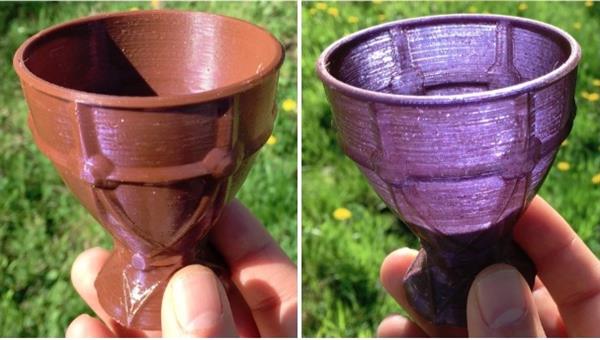Researchers from Wageningen University have fabricated a plastic cup that changes its color thanks to nanoparticles and 3D printing.
Nanotechnology is used in a wide range of researches today. If the technology is revolutionizing manufacturing processes, it should be noted that its basic usage was first applied in daily objects such as glass or pottery.
In this study, researchers manufacture a 3D printable nanocomposite composed of dichroic gold nanoparticles and a 3D printable polymer.
They firstly created a dichroic solution using a modified version of the Turkevich method in order to reduce gold ions to gold nanoparticles. It takes only a few minutes to obtain a synthesis: during this time, the color moves from the initial yellow solution of the gold ions to a blue once they have added a citrate solution. Two minutes later, the color became black before becoming dichroic after another two minutes of boiling.
« The time-dependent study shows the formation of small gold nuclei that in time cluster together forming nanowire-like structures concomitant to the first-color change. The second change of color, from ink-black to purple, is accompanied by an enhancement of the scattering, giving the purple solution a brown reflection. While boiling, the gold nanowires fragment, creating nanoparticles with a large head and a slim and long tail, comparable to a tadpole. Over time the tail starts to shrink. »
After infusing the dichroic gold nanoparticle solution into polyvinyl alcohol (PVA), the plastic was extruded filament. The researchers thereafter used it on an Ultimaker 2 to 3D print parts. The use of this material gives a look brown to the 3D printed parts when light shining on the front, but when the light was shining behind, the color becomes a transparent purple.
According to researchers, the 3D printed objects can be coated to achieve water impermeability and stability at room temperature for long time. The methodology described in this research can be used by both artists and in study of optical properties of nanoparticles or, in additive manufacturing of optical filters.
For further information, follow us on our social media and subscribe to our newsletter!
Would you like to be featured in the next issue of our digital magazine? Send us an email at contact@3dadept.com
//pagead2.googlesyndication.com/pagead/js/adsbygoogle.js
(adsbygoogle = window.adsbygoogle || []).push({});






